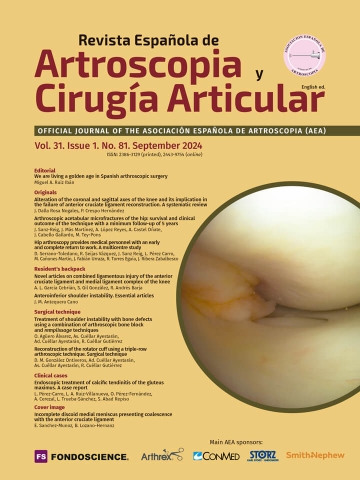We are living a golden age in Spanish arthroscopic surgery. The evolution of arthroscopic surgery in Spain over the last 20 years has been spectacular in terms of care, research and teaching.
From the point of view of care, modern arthroscopic techniques currently reach all parts of the country, and it is not necessary to travel to an exclusive and specific private centre to undergo an arthroscopic procedure with guarantees. In many healthcare centres throughout Spain there are a good number of very well trained arthroscopists who are able to resolve most of the complex joint problems our patients have, with competence and expertise.
The role of Spanish arthroscopists in international research does not go unnoticed. It is now common to find one or more Spaniards as “opinion leaders” in knee, hip, shoulder or ankle pathology, and the scientific production of our colleagues has increased not only in quantity, but also in quality. Good evidence of this is provided by two examples. On one hand, the chairman of the European Society of Sports Traumatology, Knee Surgery and Arthroscopy (ESSKA), our sister society in Europe, is a Spaniard, Dr. Monllau. On the other hand, the prestigious SECEC has chosen Dr. Valencia as chairwoman of its Research and Development Committee.
In teaching, the picture is even brighter: from an isolated handful of courses available 20 years ago, the teaching opportunities for anyone interested in receiving training in arthroscopy have multiplied. There are dozens of courses available, many involving surgery on cadavers, and following the spirit and teaching techniques pioneered by the Spanish Arthroscopy Association (AEA). Structured training has been turned around under the leadership of the AEA’s National Arthroscopy Training Plan, which has been replicated by other institutions. There are already dozens of post-resident training posts in Spain, referred to as fellows for lack of an appropriate name in Spanish, and which allow our traumatologists most interested in completing their training in arthroscopic techniques to sub-specialise in this field. All over the world, our residents undergo training, in their final years of specialisation, with the world leaders in our surgical technique, thanks in part to the connections established by these respected Spanish opinion leaders.
It is difficult to underestimate the role that the AEA has played in this radical change. In all these areas, our Society has played a key role in the development of these advances. Its training programmes have been and continue to be essential tools in the training of those surgeons who solve the complex problems of our patients, even in the centres farthest from the university institutions. The investment in research grants and the network of international contacts woven by the society have made it possible for our country’s leading figures to develop and grow as international leaders. The AEA’s training capacity, in a world where there is already much teaching available, is accessible as always to anyone with an interest in learning.
However, not all is joy and praise... There is always room for improvement. It is not uncommon to find, in recent years, at our national congress, with an increasing number of attendees, rooms with sessions of obvious interest and quality that are empty or half-empty; or sessions of oral communications, which theoretically represent the spearhead of Spanish arthroscopy research, in which these international opinion leaders are conspicuously absent.
Our Revista Española de Artroscopia y Cirugía Articular (REACA) is also languishing for lack of original articles. Despite the efforts made by the Society to boost its publication and open up access to it on the part of the English-speaking world thanks to its full English translation, the journal is now unfortunately further away from indexing than it was three years ago. With the clear exception of our hip arthroscopy colleagues (as can be seen in this issue), few Spanish research groups bear in mind that publishing their findings in REACA offers an opportunity to introduce new researchers, train them in how to publish, and support the AEA.
Let us all congratulate ourselves on the successes achieved and on the good path prepared by our predecessors, but let us also look ahead to see where we can improve.
Miguel A. Ruiz-Ibán
Director of the REACA





